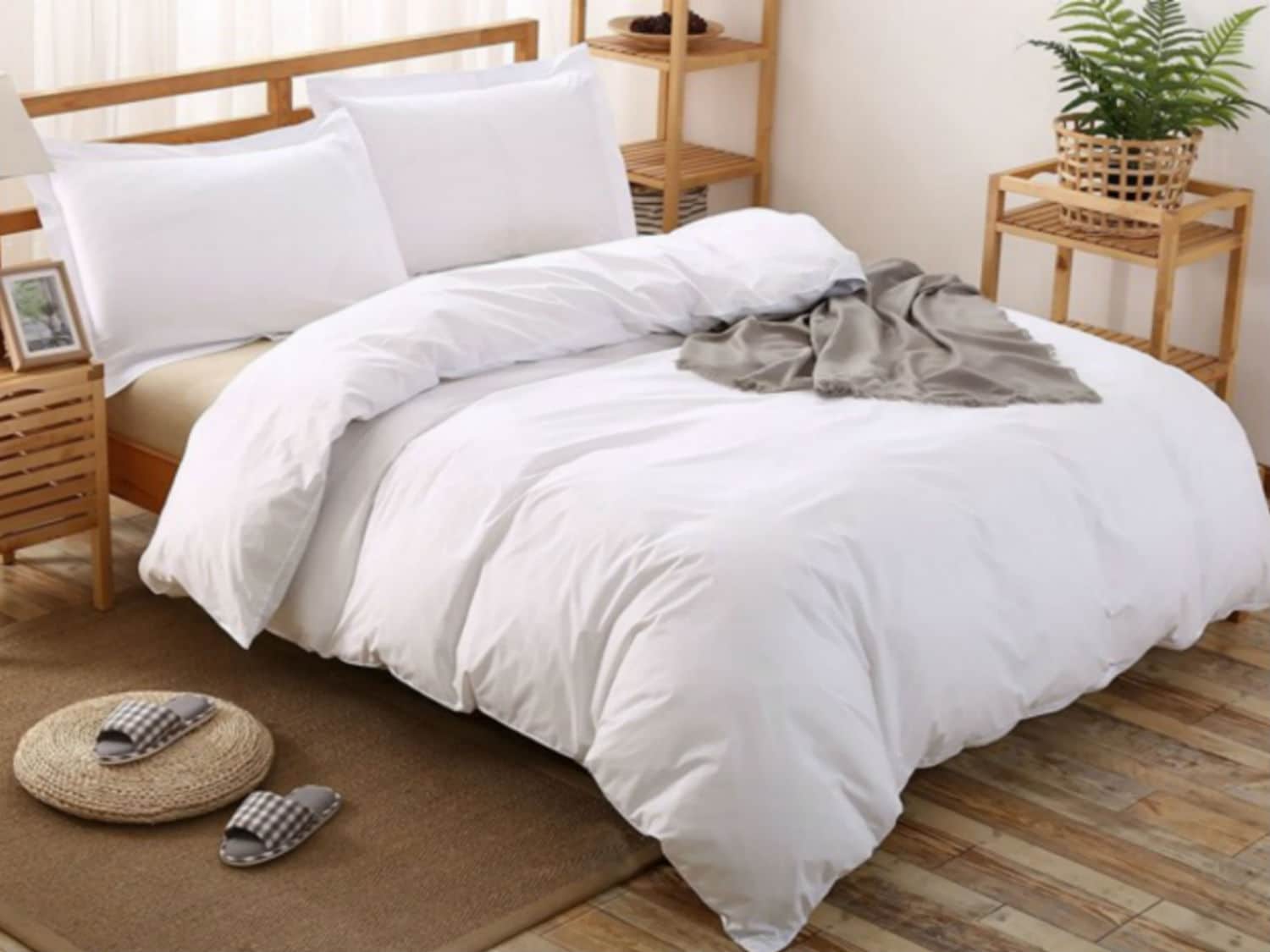Benefits of a Duvet Cover

Americans protect pillows with pillowcases, but many neglect to protect comforters. This sounds rather counter-intuitive given that comforters are bigger and therefore more difficult and more expensive to clean or replace than pillows. A duvet cover is a big pillowcase for your duvet (also called comforter) and serves the same purpose as a pillowcase for a pillow. Instead, many Americans opt to use their blankets with just a flat sheet (“top sheet”). Foreigners perceive such American bed making tradition as unhygienic. The clash of cultures is apparent on social media where the use of blankets without duvet covers is equated to the use of pants without underwear. Foreign tourists have been expressing their disgust with the American hotels that offer to their guests reused, unwashed blankets and bedspreads not encased in freshly washed duvet covers. European hotels offer to each guest a clean duvet cover. Not using a duvet cover is in part attributed to Americans’ fast pace of life – it is allegedly faster to change a top sheet as opposed to a duvet cover. However, any time savings would be very minimal especially if you are making hospital corners with your top sheet.
Duvet covers are more popular in Europe but recently they have been gaining popularity in the US as well. Americans are starting to realize the benefits of a duvet cover.
Improves longevity of your comforter
One of the reasons the Europeans have been able to pass their comforters on to the next generation is the encasement of their comforters in duvet covers. Such simple protection makes the shell of the comforter last longer. A traditional European bed sheet set includes a duvet cover instead of a flat sheet. In the US, the sheet choices are rather unusual. They are not designed to protect comforters. An American bed sheet set includes a fitted sheet, a flat sheet and pillowcases. It does not include a duvet cover! An American duvet cover set includes a duvet cover and pillowcases. It does not include a fitted sheet! Are people supposed to sleep on a bare mattress? So in order to have a complete bed sheet set that can protect your comforter, you have to buy two sets of linens and end up with extra pillowcases and a useless flat sheet. Some brands, such Parachute, ditched top sheets and began offering the sheet sets without it.
The advocates of flat sheets state that a flat sheet provides adequate protection to a comforter by creating the buffer between your body and the comforter. Others say that sleepers can use both a flat sheet and a duvet cover. The fact is that unless you lay motionless in a deep comma, your flat sheet will get kicked to the bottom or the side by the morning. Some people also say that there is no need for a duvet cover because you can wash your comforter instead. The counterargument is that unprotected comforters wear out faster and the cost of replacement of a comforter is usually much higher than the price of a duvet cover. Some comforters cannot be washed at all. Even if your comforter is washable frequent washing generally decreases a comforter’s useful life because the shell becomes weaker and the filling tends to become compressed or lumpy and therefore less insulating.
Keeps comforter clean
Comforters without covers get exposed to body oil, makeup, dust, pet hair, and often drinks and food. Some sleepers attempt to protect their comforters with a flat sheet, but it will never offer the same protection as a duvet cover. A flat sheet may briefly cover one side of your comforter but it will always slip off because it is not anchored to the comforter. A duvet cover, on the other hand, will protect your whole comforter and will stay put because zippers, buttons or ties keep it closed with the comforter fully enveloped inside of it. Recently, the bedding industry developed a duvet cover with inner corner ties where the cover is tied to the corner loops of a comforter and the comforter does not bounce around inside its cover.
Easier to clean than comforters
Many comforters require special care. Some comforters are so thick or so big that they will not fit into your home washer or dryer. If you happen to have a house in a rather cold state like North Dakota, Maine or Vermont, and do not have a warm comforter in winter, you will pay a fortune for your heating. Having a 600gsm Camel wool winter comforter will save you quite a few bucks. That baby pays for itself in reduced heating bills but it is big and fat, and may ruin your washer. Taking it to a commercial laundromat hoping to find a big heavy duty machine is a hassle. That is the reason why you need a removable washable duvet cover. Some comforters, such as mulberry silk comforters, can sag or shrink after washing. Wool comforters may felt (become lumpy) after washing or machine drying.
The bottom line is that a comforter is not as easy to maintain as a duvet cover, while the care of a duvet cover is as simple as the care of your bed sheets. It is easy to take off your duvet cover and toss it into a washer. Duvet covers also dry fast. It makes more sense to wash a duvet cover rather than a comforter unless your comforter is badly soiled.
Comforters without covers get dirty and may develop a foul odor. Good luck trying to date someone with a stinky filthy comforter in your bedroom. How romantic is that? Sex therapists and marriage counselors agree that fresh clean bedding makes couples feel better and improves their sex lives.
Can be used as flat sheet or a light cover
A duvet cover can replace a blanket in hot summer months. It can be used as a flat sheet while you store your warm comforter for the off-season. That is especially recommended for hot sleepers. A fancy duvet cover can also be used as a bedspread.
Soft duvet cover makes comforter feel better
This is true in cases where the shell of the comforter is made of a rough fabric such as linen or some scratchy polyester. No matter how much fabric softener you dump in your washer or how long your comforter gets beaten by tennis balls in the dryer, the fabric may not get softer.
Can prevent shedding
If your comforter is filled with coarse filling that migrates through the shell, then a duvet cover can cure the problem. If you look like a sheep in the morning with your pj’s covered in wool or if flying feathers make you think it is snowing in your bedroom, then an additional layer of fabric around your leaky down or wool comforter may make worth keeping it.
Can adjust temperature of your comforter
A flannel duvet cover will keep you toasty in winter while a linen, tencel or cotton duvet cover can keep you cooler in summer.
Can reduce the noise of new crinkly sounding comforter
A comforter is made out of some insulating thick material sandwiched between two pieces of cloth. To prevent the filling from penetrating the shell the manufacturers use a tightly woven high thread count fabric. It may sound like a paper bag when you move. Your blanket will typically get quieter the longer you use it, but in the meantime a soft duvet cover may at least partially neutralize that annoying noise.
Improves aesthetic appeal of your bedroom
You can easily refresh the decor of your bedroom by introducing a new duvet cover and pillow shams. The only problem in the US is that there are no standard size duvet covers. Different manufacturers make different size comforters for the same bed size. That presents challenges in finding the right size duvet covers. In many cases duvet covers need to be special ordered or altered. Organic Comfort Market offers classic white duvet covers that are custom made for the company’s comforters eliminating the stress associated with finding correct size covers.


 Pay in 4 lets you split your purchase into 4 interest-free payments. The first payment will be due at the time of purchase and 3 subsequent payments will be taken every 2 weeks thereafter. PayPal account that can be set up at the time you choose to pay with PayPal. Your item ships after you put down 25%.
Pay in 4 lets you split your purchase into 4 interest-free payments. The first payment will be due at the time of purchase and 3 subsequent payments will be taken every 2 weeks thereafter. PayPal account that can be set up at the time you choose to pay with PayPal. Your item ships after you put down 25%.